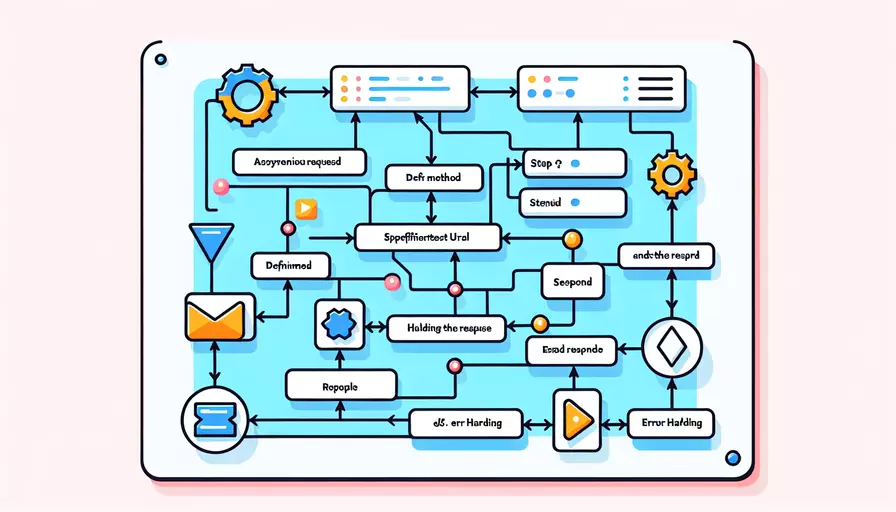
Vue.js 实现异步请求主要通过以下几种方式:1、使用内置的fetch API,2、使用第三方库axios,3、Vue 组件生命周期钩子函数。这些方式能够帮助开发者在Vue应用中进行数据获取和处理,以实现动态内容的展示。
一、使用内置的`fetch` API
fetch API 是现代浏览器中内置的用于发起网络请求的接口,具有简单易用的特性。以下是使用fetch API的步骤:
- 发起GET请求:
fetch('https://api.example.com/data').then(response => response.json())
.then(data => {
console.log(data);
})
.catch(error => {
console.error('Error:', error);
});
- 发起POST请求:
fetch('https://api.example.com/data', {method: 'POST',
headers: {
'Content-Type': 'application/json'
},
body: JSON.stringify({ key: 'value' })
})
.then(response => response.json())
.then(data => {
console.log(data);
})
.catch(error => {
console.error('Error:', error);
});
解释和背景信息:
fetchAPI 返回的是一个Promise对象,可以很方便地使用.then()方法进行链式操作。- 使用
fetch时需要处理网络错误和HTTP错误,通常可以通过.catch()来捕获异常。 fetch的默认行为不会自动抛出HTTP错误,需要手动检查response.ok属性。
二、使用第三方库`axios`
axios 是一个基于Promise的HTTP库,具有更丰富的功能和更好的兼容性。以下是使用axios的步骤:
- 安装
axios:npm install axios - 发起GET请求:
import axios from 'axios';axios.get('https://api.example.com/data')
.then(response => {
console.log(response.data);
})
.catch(error => {
console.error('Error:', error);
});
- 发起POST请求:
axios.post('https://api.example.com/data', {key: 'value'
})
.then(response => {
console.log(response.data);
})
.catch(error => {
console.error('Error:', error);
});
解释和背景信息:
axios支持在浏览器和Node.js中运行,具有更好的跨平台兼容性。axios可以配置全局默认值、创建实例以及取消请求等高级功能,非常适合在大型项目中使用。- 相比于
fetch,axios会自动处理一些常见的请求和响应转换,减少手动操作的复杂性。
三、Vue 组件生命周期钩子函数
在Vue组件中,常常需要在组件创建或挂载时进行异步请求。Vue提供了一些生命周期钩子函数来实现这一需求:
- 在
created钩子中发起请求:export default {data() {
return {
info: null
};
},
created() {
fetch('https://api.example.com/data')
.then(response => response.json())
.then(data => {
this.info = data;
})
.catch(error => {
console.error('Error:', error);
});
}
};
- 在
mounted钩子中发起请求:export default {data() {
return {
info: null
};
},
mounted() {
axios.get('https://api.example.com/data')
.then(response => {
this.info = response.data;
})
.catch(error => {
console.error('Error:', error);
});
}
};
解释和背景信息:
created和mounted是Vue组件的生命周期钩子函数,分别在组件实例创建完成和挂载到DOM后调用。- 在
created钩子中发起请求,可以确保组件在数据准备好之前不会渲染。 - 在
mounted钩子中发起请求,适用于需要操作DOM元素的情况。
四、处理异步请求的状态
在实际开发中,需要处理异步请求的各种状态(如加载中、成功、失败)。可以使用Vue的响应式数据和条件渲染来实现:
- 定义请求状态:
export default {data() {
return {
info: null,
isLoading: false,
error: null
};
},
methods: {
fetchData() {
this.isLoading = true;
this.error = null;
axios.get('https://api.example.com/data')
.then(response => {
this.info = response.data;
})
.catch(error => {
this.error = error;
})
.finally(() => {
this.isLoading = false;
});
}
},
created() {
this.fetchData();
}
};
- 在模板中显示状态:
<template><div>
<div v-if="isLoading">加载中...</div>
<div v-if="error">发生错误: {{ error.message }}</div>
<div v-if="info">数据: {{ info }}</div>
</div>
</template>
解释和背景信息:
isLoading用于表示请求进行中的状态,error用于捕获和显示请求错误。- 使用Vue的条件渲染指令
v-if和数据绑定,可以动态显示不同的状态信息,提高用户体验。
五、结合Vuex进行状态管理
在复杂应用中,使用Vuex进行状态管理可以更好地处理异步请求和数据共享:
- 安装Vuex:
npm install vuex - 创建Vuex store:
import Vue from 'vue';import Vuex from 'vuex';
import axios from 'axios';
Vue.use(Vuex);
export default new Vuex.Store({
state: {
info: null,
isLoading: false,
error: null
},
mutations: {
setLoading(state, isLoading) {
state.isLoading = isLoading;
},
setInfo(state, info) {
state.info = info;
},
setError(state, error) {
state.error = error;
}
},
actions: {
fetchData({ commit }) {
commit('setLoading', true);
commit('setError', null);
axios.get('https://api.example.com/data')
.then(response => {
commit('setInfo', response.data);
})
.catch(error => {
commit('setError', error);
})
.finally(() => {
commit('setLoading', false);
});
}
}
});
- 在组件中使用Vuex:
export default {computed: {
info() {
return this.$store.state.info;
},
isLoading() {
return this.$store.state.isLoading;
},
error() {
return this.$store.state.error;
}
},
created() {
this.$store.dispatch('fetchData');
}
};
解释和背景信息:
- Vuex 是Vue.js官方提供的状态管理模式,专为管理应用中共享状态设计。
- 使用Vuex可以将异步请求的逻辑集中管理,增强代码的可维护性和可测试性。
- Vuex的
actions用于执行异步操作,mutations用于修改状态,state存储应用的状态数据。
总结:在Vue.js中实现异步请求有多种方式,包括使用内置的fetch API、第三方库axios、组件生命周期钩子函数以及结合Vuex进行状态管理。选择合适的方式取决于项目的复杂度和具体需求。合理处理异步请求的状态和错误,可以提高用户体验和应用的稳定性。建议开发者根据项目需求,灵活运用这些方法,以实现高效的数据请求和处理。
相关问答FAQs:
Q: Vue如何实现异步请求?
A: Vue可以通过使用Axios或Vue Resource等库来实现异步请求。以下是两种常用的方法:
1. 使用Axios进行异步请求
Axios是一个流行的基于Promise的HTTP客户端,可以在Vue中轻松地进行异步请求。首先,你需要使用npm安装Axios:
npm install axios
然后,在你的Vue组件中引入Axios:
import axios from 'axios';
接下来,你可以在Vue的方法中使用Axios来发送异步请求。例如,使用Axios发送GET请求:
axios.get('/api/data')
.then(response => {
// 请求成功时的处理逻辑
console.log(response.data);
})
.catch(error => {
// 请求失败时的处理逻辑
console.log(error);
});
你也可以使用Axios发送POST请求、PUT请求等。Axios提供了丰富的配置选项和拦截器,使得处理异步请求更加灵活和方便。
2. 使用Vue Resource进行异步请求
Vue Resource是Vue官方推荐的HTTP库,它可以通过Vue插件的形式集成到Vue中。首先,你需要使用npm安装Vue Resource:
npm install vue-resource
然后,在你的Vue组件中引入Vue Resource:
import VueResource from 'vue-resource';
接下来,你可以在Vue的方法中使用Vue Resource来发送异步请求。例如,使用Vue Resource发送GET请求:
this.$http.get('/api/data')
.then(response => {
// 请求成功时的处理逻辑
console.log(response.body);
})
.catch(error => {
// 请求失败时的处理逻辑
console.log(error);
});
Vue Resource也提供了类似Axios的丰富配置选项和拦截器,以及更多高级功能,如拦截响应和转换请求等。
无论你选择使用Axios还是Vue Resource,都可以轻松地在Vue中实现异步请求。这些库都提供了简洁的API和强大的功能,使得处理异步请求变得更加简单和高效。
文章标题:vue如何实现异步请求,发布者:worktile,转载请注明出处:https://worktile.com/kb/p/3636356

 微信扫一扫
微信扫一扫  支付宝扫一扫
支付宝扫一扫 